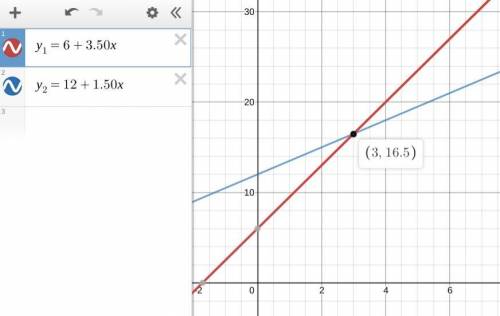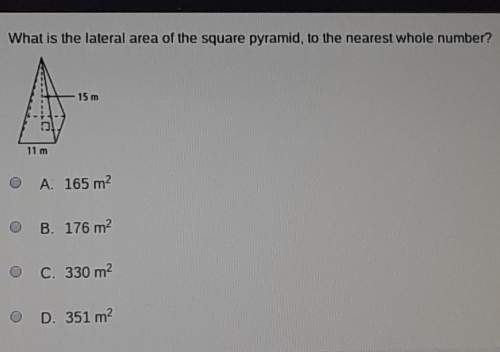
Mathematics, 27.02.2021 04:30 adrianvigil6400
12) A new amusement park decides to offer its visitors a choice between two plans. With Plan 1 they pay $6 to enter
the park and they pay $3.50 for each ride. With Plan 2 they pay $12 to enter the park and $1.50 for each ride. Write an
equation then find the number of rides when the cost will be the same. What will that cost be?

Answers: 1


Another question on Mathematics

Mathematics, 21.06.2019 16:30
Jorge planted flowers in his garden he planted one row of 12 tulips and one row of 36 daisies george's friend kylie has a garden with 75 flowers in it kylie's garden only contains tulips and daisies. is it possible for kylie‘s garden she have the same ratio of tulips to daisies as george's garden?
Answers: 1

Mathematics, 21.06.2019 19:30
Plz.yesterday, the snow was 2 feet deep in front of archie’s house. today, the snow depth dropped to 1.6 feet because the day is so warm. what is the percent change in the depth of the snow?
Answers: 1

Mathematics, 21.06.2019 20:10
A. use the formula for continuous compounding with the original example: $1000 invested at 2% for 1 year. record the amount to 5 decimal places. use a calculator. b. compare it to the result using the original compound interest formula with n = 365 calculated to 5 decimal places. which has a larger value? explain.
Answers: 1

Mathematics, 21.06.2019 21:40
Write the contrapositive of the conditional statement. determine whether the contrapositive is true or false. if it is false, find a counterexample. a converse statement is formed by exchanging the hypothesis and conclusion of the conditional. a) a non-converse statement is not formed by exchanging the hypothesis and conclusion of the conditional. true b) a statement not formed by exchanging the hypothesis and conclusion of the conditional is a converse statement. false; an inverse statement is not formed by exchanging the hypothesis and conclusion of the conditional. c) a non-converse statement is formed by exchanging the hypothesis and conclusion of the conditional. false; an inverse statement is formed by negating both the hypothesis and conclusion of the conditional. d) a statement not formed by exchanging the hypothesis and conclusion of the conditional is not a converse statement. true
Answers: 1
You know the right answer?
12) A new amusement park decides to offer its visitors a choice between two plans. With Plan 1 they...
Questions


History, 21.07.2019 16:30






Mathematics, 21.07.2019 16:30

Mathematics, 21.07.2019 16:30

Chemistry, 21.07.2019 16:30




Mathematics, 21.07.2019 16:30

History, 21.07.2019 16:30




Biology, 21.07.2019 16:30





